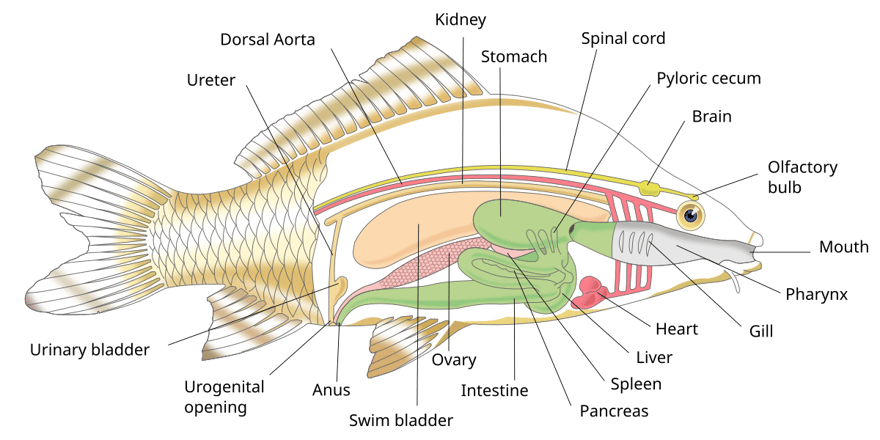Digestive System in Fish: Alimentary Canal & Digestive Glands Explained
The digestive system in fish consists of the alimentary canal and digestive glands, including the buccal cavity, stomach, intestine, liver, and pancreas. Learn about their structure and functions in fish digestion.
STUDY ZONE
Digestive System In Fish
FAST SUMMING 🆙-
A group of organs that break down food and liquids into nutrients that the body can use is known as Digestive system.
Digestive system is divided into 2 parts i. e.
Digestive system in fish:-
★ Alimentary canal
The major parts of the alimentary canal are buccal cavity, pharynx, oesophagus, stomach, intestine and cloaca.
Buccal cavity:
- The mouth present on the ventral side of the head is small crescentic or semi oval and bounded by jaws.
- The lower jaw is movable, limbs are absent, jaw is covered by spiny skin.
- Teeth are sharp, homodont, backwardly directed polyphyodont and mainly used for grasping of prey.
- Pallet is absent, the skull forms the root of the buccal cavity.
Tongue:
- Tongue is small, non muscular, non glandular, non protrusible attached at the base, lacking test buds, not used in food capture.
Pharynx:
- Buccal cavity marges insensibly into a large posterior pharynx.
- It is a soft wide tube with thick, muscular wall, longitudinal mucous folds and opening into the cardiac stomach with a sphincter or Esophageal valve.
Stomach:
- It is large, muscular, U-shaped, or S-shaped, divided into a long broad proximal cardiac stomach and short narrow distal pyloric stomach.
- Junction of the two marked by a blind sac and a sphincter valve.
- Longitudinal mucous folds well developed in the cardiac part.
- The pyloric stomach opens through the pyloric valve into the bursa entiana
Small intestine:
- There is no external differentiation between duodenum and ileum.
- Mucous lining of intestine folded into spiral valve and villis are absent.
- Sacculus rotundus is absent.
Large intestine:
- The last part of the intestine forms a short rectum of narrow diameter opening into the cloaca.
- Caecum and vermiform appendix absent.
- A tubular rectal gland of unknown function opens dorsally into rectum.
Cloaca:
- The rectum opens behind into a simple cloaca through anus guarded by the anal sphincter.
- Bursa fabricius absent.
- Cloaca opens by a mid ventral longitudinal slit between pelvic fins.
★ Digestive glands in fish
- Mucus gland and salivary glands are absent.
- Gastric glands are present in the stomach.
- Gastric juice contains pepsin and HCl.
- The other major glands are liver and pancreas.
Pancreas:
- A compact, whitish and bilobed gland found between cardiac and pyloric stomach.
- Pancreatic duct opens as a single independent duct into the proximal end of the intestine.
Liver:
- It is a massive, yellowish, bilobed gland in the abdominal cavity.
- The gallbladder is Y-shaped thick walled and attached to the right liver lobe.
- A single bile duct opens independently into the beginning of the intestine.


Fig . Digestive system of fish.
References:
Kapoor, B. G., Smith, H., & Verighina, I. (1975). The alimentary canal and digestion in teleosts. Advances in Marine Biology, 13, 109-239.
Wilson, J. M., & Castro, L. F. (2011). Morphological and functional diversity of the gastrointestinal tract in fishes. Fish Physiology, 30, 1-55.
Ferraris, R. P., & Ahearn, G. A. (1984). The intestinal nutrient transport of teleost fishes. Comparative Biochemistry and Physiology Part A: Physiology, 77(3), 397-413.
Horn, M. H. (1989). Biological processes regulating food intake and digestion in herbivorous fishes. Reviews in Aquatic Sciences, 1(1), 91-116.
Jobling, M. (2012). Fish Bioenergetics. Springer Science & Business Media.
Evans, D. H., Claiborne, J. B., & Currie, S. (2013). The physiology of fishes (4th ed.). CRC Press.
ADVERTISEMENTS
ADVERTISEMENTS

Drop Us a Line
We’d Love to Hear from You
